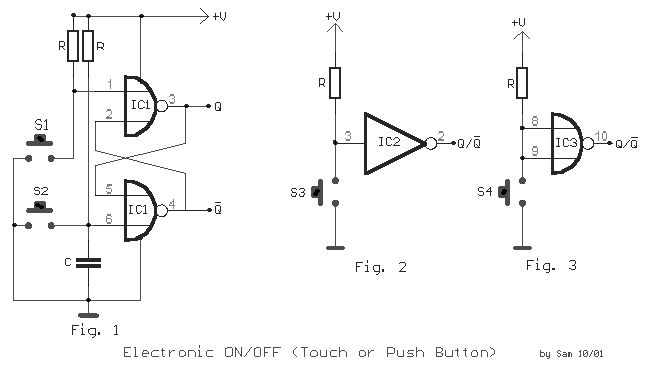��� ������ ����� ��������, �� ��� ������ ��������
�� ��������� ������������� ��������� ���
������������� ��� ��� ��� � ���������� (Push button).
���������������� ���� ��� ���� ������ ���������
������� ��� ������������ �� ����� CMOS. ��� Fig.1
������ ��� ����� NAND � NOR ( IC1) �����������������
��� R-S flip-flop. ����� �������� ��� �������� S1�
������ 3 ������� � ��� ����������� �� ���� ���
��������� . ��� �� ������� � ��������� ������ ��
�������� ��� �������� S2 . ���� � ������ 3 , �������
���� (L), �������� � ������ 4 ������� (H). ��� ��
���������� ��� ��������� ��� ������� , ��������
�� ���������� ��������� �� ��� ����������
��������, ���� ������� C=100nF. ���� � ������� ��
������ ����� ��� ���������� ����� �� ������ (L)
������ ���� ��� ������ ����������� ��� �������.
��� ����� Fig. 2, ������ ��� ������� ���������� CMOS
���� ������ ��� ������ ����������� ������
��������� (H) ��� ��� ��������� R, ��� ������ � ����
���� ����� ���� ����������. � ������ 2 ����
��������� (L). ���� �������� ��� �������� S2, ����
������ 3 ��� IC2, ������ ��������� (L), ���� ��� ����
�������� ���� ��, � ������ ���� ������� (�). ��
����������� ����� ������������ ��� �������
�������� ��� �������� S2 ��� �������� ������
����� ��� ��������. ��� ������� �������� ������
���������� ���� �� ������ �� ���������� ���
��������� R, ���� �� ��� ��� �������� S2, ����
����������. ��� ���� ������ �� ������ ���
���������������� ��� ���� IC2, �� ��� ���� NAND � NOR,
���� �������� ��� ����� Fig. 3, �� ���������� �����
�� ����. ������ � ��������� ���� ��������� ���
�������� 1 ��� 3, ��� ��������� ������� ���
������� ���� ���������� �� ������� ���, ��� ��
��� �������������, ������ �� ���������� ��� J-K � D
flip-flop ��� �, ���� �� IC2 ��� IC3. ���� �� flip-flop, ��
������� ��������� ���� ���� ��� �� ������ ���
�������� � �� ��������� ��� ������ ��� �� ���
���������. ���� �� ��������� ������� ��
��������������� �� ������ , ����� ��
���������������� ��� ��� ����������� R �� ���
���� ��� 10��. �� ����������� R ����
�������������� ���������� ��������� ������ ��
����� , ��� 100�� ��� 1��. ������ ����
�������������� ������ ���� ��� ���������, �
������� ������ �� ��������� ��� ����� ���
�������� 2 ��� 3, ���� �������� �� �������������
��� ������� 100nF, ��������� �� ��� ������.
Here we have three choices, with which we can
make electronic switches that use our touch or pressing (push button). We thus exploit the
very big resistance of entry, that present the gates CMOS. In the fig.1 we have two gates
NAND or NOR (IC1), connected as R-S flip-flop. Just as we press the switch S1, the exit 3
it becomes [H], even it is maintained in this situation. To change the situation, it
should we press switch S2. Now exit 3, takes price (L), reversely exit 4 becomes (H). In
order to we maintain the situation that we want, we can connect at parallel with the
corresponding switch, a capacitor C=100nF. This entry will always drive the corresponding
exit to logic (L), immediately afterwards the benefit of supply to the circuit. In the
fig. 2, we have a circuit of inverter CMOS, in the entry of which is applied logic
situation (H), from the resistance R, which the other end of, is in the supply. Exit 2 has
situation (L). When we press switch S2, in the entry of 3 IC2, we have situation (L), this
it goes to the ground, the exit now becomes (H). This situations are maintained as long as
we keep pressed switch S2 and they change immediately hardly the touch. If we want
opposite logic operation then it will be supposed we connect the resistance R, in the
ground and switch S2, in the supply. The same logic we will have if we replace gate IC2,
with a gate NAND or NOR, as it appears in the fig. 3, the result is the himself. Because
the situation in the case of fig.1 and 3, does not remain constant and change when we pull
our finger , in order to him we retain, it should we connect a J-K or D flip-flop as T,
after the IC2 and IC3. Thus the flip-flop, will change situation, each time where we will
touch the switch or will touch the contacts and him it will retain. All the switches can
be replaced with contacts, it is enough we replace also resistances R with the price of
10M�. The Resistances R when we use pressing switches can are, from 100K� until 1M�.
Because when we use contacts instead of switches, the noise can turn on the gates of fig.
2 and 3, then can place a capacitor 100nF, parallel with the contacts. |
